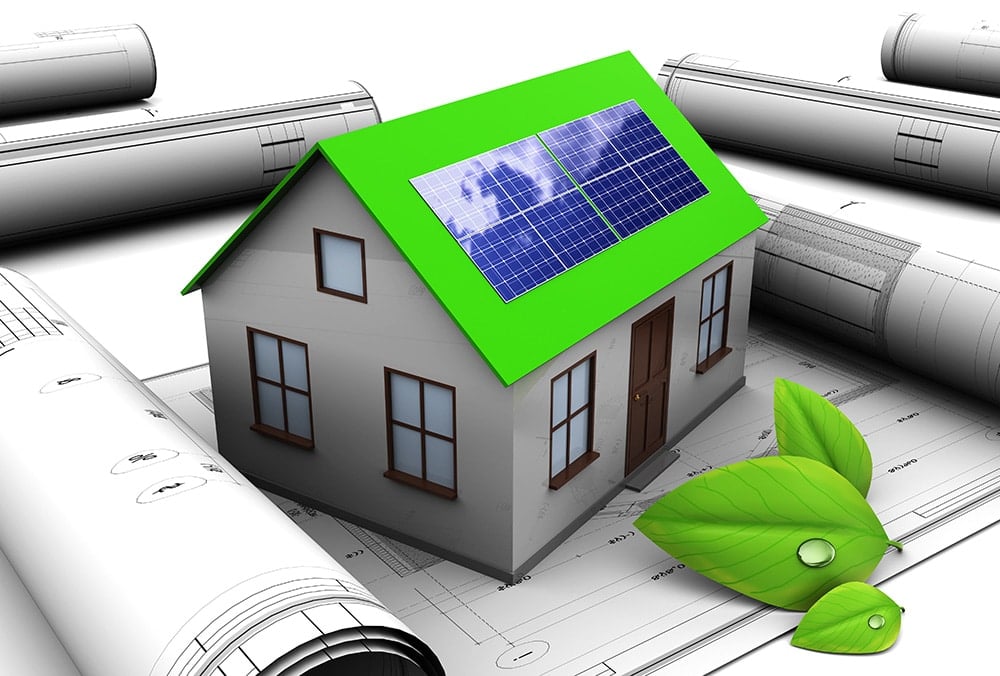Running your home takes energy — there’s no way around it. But that doesn’t mean you have to rely on carbon-producing fossil fuels. Instead, you can integrate renewable resources into your home. Looking for ideas? Then, check out the following.

1. Invest in solar panels
Solar panels are one of the most effective ways to add renewable energy to your home. Although the panels are expensive, they save the average homeowner $10,000 to $30,000 over the lifetime of the panels. And the good news is that you don’t have to pony up the cash immediately. There are a variety of programs that allow you to spread the cost over time.
Before jumping in, however, make sure you understand what you’re paying for. With some plans, you finance the solar panels over time, making monthly payments to the supplier. In other cases, you rent the panels. The right choice depends on your situation.
You can also choose between solar panels on their own or combined with batteries. With the first option, you can connect to the grid, and any excess energy produced goes back into the grid. At that point, your utility company gives you credit for the energy.
This arrangement is called net metering, which just means that you pay for the energy you consume minus the energy you produce. The exchange rate varies. With some utility companies, you get a credit equal to the cost you pay, while with others the credit is a portion of the amount you pay for power.
2. Embrace passive solar strategies
You don’t have to invest in solar panels to enjoy the energy-producing benefits of the sun. You can employ all sorts of strategies to embrace passive solar energy. Consider the following:
- If you’re building a home or looking for an energy-efficient home, insist on south-facing windows. They will absorb the sunlight in the winter and help to keep your home warm.
- Shade south-facing windows during the summer. Install awnings or even just leave the shades down to prevent these windows from bringing in excess heat during the summer.
- Add triple or double glazing with low-e glazing to all windows that don’t face south. Low-e coatings help to bring in heat during the winter, and they prevent unwanted heat gain during the summer.
- When possible, consider adding solar mass. Concrete slabs, brick walls and fireplaces, and even tile floors can serve as solar masses, and in fact, all homes have some solar mass. These elements help to hold heat in the winter and keep your home cooler in the summer.
- If your home has a lot of passive solar elements, they will affect the operation of your HVAC equipment. Generally, you need a lower capacity HVAC system than you would need if you didn’t have a lot of passive solar elements. When buying new equipment, work with an HVAC pro who does a full Manual J calculation to ascertain the ideal capacity of your equipment.
You can also indirectly embrace “passive wind energy” by allowing a cross breeze to go through your home on summer days. Or if it’s too hot in your area for this strategy to work, you can open the windows at night when the temps drop. Then, close them in the morning to lock in the cold air.
3. Look into residential wind energy systems.
If you have at least an acre of land and live in an area where the winds are often above 10 mph, you may be a good candidate for a residential wind energy system. Then, you can put in a turbine that will generate electric energy for your home.
4. Select an electric company that uses renewable wind sources
Even if you cannot reasonably put a wind turbine on your property, you can still use wind to create your electricity if you choose the right electric provider. When shopping for an electric company, look for a provider that uses renewable sources.
Stay away from electric companies that operate a lot of coal-powered plants. Instead, look for companies that generate power with wind, solar, or hydro-energy. In some areas, you can also find power created by anaerobic digesters.
5. Install a ductless heat pump
Once you’ve figured out how to get your electricity from renewable sources, the next step is to embrace electric appliances. A ductless heat pump can replace your fossil fuel-based furnace, and it can also provide you with energy-efficient cooling during the summer.
In addition to being able to run off your solar panels or clean energy from your utility provider, ductless heat pumps operate extremely efficiently. They move heat, rather than generate it, and this reduces energy consumption significantly. Although the exact savings vary, the average homeowner in the Northeast saves about $500 to $1,000 per year when they switch.
Contact N.E.T.R. for Help Today
At N.E.T.R., we work hard to help our clients create more energy-efficient homes, but we’re also all about comfort. When you switch to an air-source heat pump, you’ll enjoy energy savings, but you’ll also have a more comfortable home with more consistent heating and cooling.
Ready to harness renewable energy sources and enjoy the benefits of a heat pump? Then, contact us today. We’ll help you select the right heat pump or other HVAC solution for your home.
